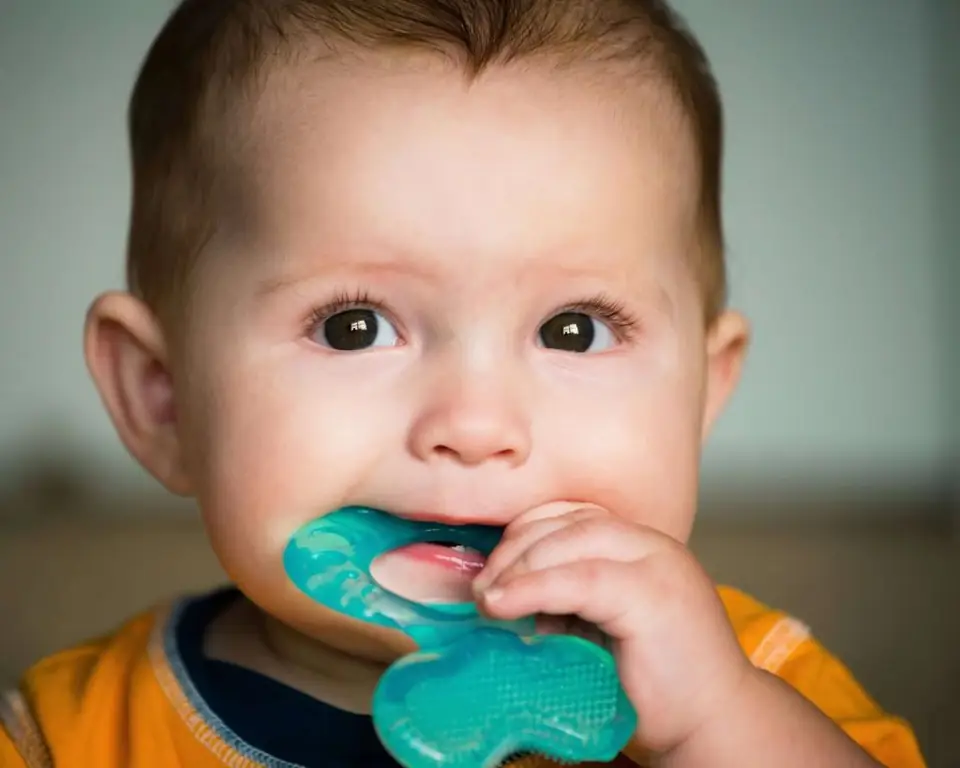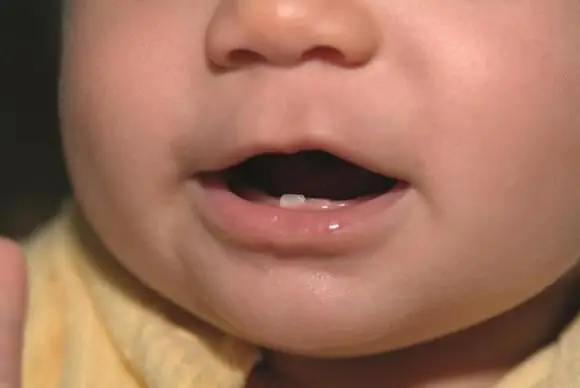2026 Author: Priscilla Miln | [email protected]. Last modified: 2025-01-22 17:55:16
As a rule, parents impatiently wait for the child to start teething. They worry in advance that the first ones will go too painfully. Very often, when teeth are cut, the symptoms really resemble a disease: the temperature rises, the baby is naughty, etc. Neither parents nor doctors can influence the natural process of teething. This difficult time is a must.

What not to do?
Don't constantly look into your baby's mouth and show how worried you are. Thus, you will only worsen the emotional state of the child. You should also not worry about the fact that teeth are cut very early or do not grow at all, although the baby is already six months old. You probably have not met people who have never had teeth. They will definitely appear.
How do you know if a baby is teething?
Usually, as soon as the baby turns six months (and sometimes only four months), any ailment in the child is attributed by the parents to the fact that teeth are being cut. Symptoms and signs of this process they are readyto see every time the child has a temperature or is naughty.

How dangerous is this approach?
It is from six months that the risk of catching a cold or infection becomes higher, since even in breastfed babies, during this period, the body does not have the antibodies that they received in the womb. Then the baby begins to develop its own immunity. You should not think that if dad is sick, and the child has a runny nose, then this is a sign of cutting teeth. It is not necessary to write off all diseases for teething. Parents just need to be aware that when teething, the symptoms can manifest as a cold. This is a rather painful process that can worsen the condition of the child, but only moderately. If your child suffers from a high temperature, does not want anything, eat and drink, then such symptoms cannot be a manifestation of cutting teeth. A doctor should be called immediately.

Teething symptoms
The main signs can be considered the following: salivation increases, the child wants to constantly gnaw something and pulls everything into his mouth. As a rule, the gums turn red, they become inflamed and swell. The temperature during teething can also rise. Usually it does not rise above 38 degrees and lasts no more than 3 days. Runny nose and cough can also be considered symptoms. But if the cough is very strong, and the discharge from the nose is green and plentiful, then these are already symptoms of an acute respiratory disease, but notteething. Some parents on the forums talk about the fact that during teething, the child begins to have diarrhea. This symptom should also be treated with special attention. During teething, the stool may only be slightly loose. If the stool is liquid and frequent and accompanied by fever and deterioration of he alth, then this may indicate that there is an intestinal infection in the body, so the baby should be shown to the doctor.
Recommended:
The order of teething in children under one year old: sequence, timing and symptoms

Sometimes teething in babies can cause a lot of trouble not only for the children themselves, but also for their parents. This period is different for everyone. Some babies can easily tolerate the discomfort caused by teething, while others may notice the appearance of fever, diarrhea and a number of other symptoms
When children start teething: age, symptoms, photos

Stories about the time when a child's first tooth is cut scare many parents. Indeed, colic and pain from teething is what darkens the first year of the crumbs a little. But if the parents are calm, have information and know how to help the baby, then everything turns out to be not so scary
Teething in children: symptoms, sequence, timing

At some point, parents are faced with a very difficult period for the baby, associated with the onset of teething. For some, it passes quite calmly, while others face whims and a significant decrease in immunity in the child. This causes fever, diarrhea and some other unpleasant symptoms. Further in the article, we will look at the order of teething in children and find out how they can be helped during this period
How long does the temperature last when teething? What temperature during teething is acceptable?

In this article I would like to talk about how long the temperature lasts during teething, and also what it can be, how you can help the baby with medicines and in other ways, what you should not do. Read all about it in the text below
Symptoms of teething in a child. How to help a child with teething

Teething starts at about 6-9 months of age. As a rule, these are the lower incisors. By 16-22 months it is time for the upper and lower canines. Most mothers know that teething these teeth is not easy. What are the symptoms of teething teeth in a child? How to lighten them?

